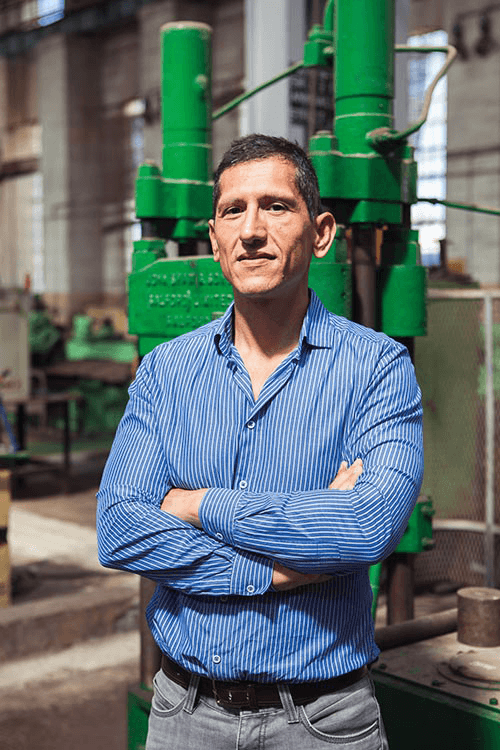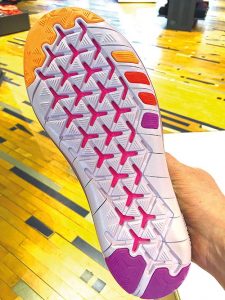Prof. Joseph N. Grima’s work on auxetic metamaterials has been lauded the world over. Now that NIKE has released a shoe with an auxetic sole, he talks to Clemens Uhl about his thoughts on sharing knowledge.
Many innovators look to nature for inspiration. When Swiss electrical engineer George de Mestral was on a walk with his dog in 1941, he noticed how cockleburrs in the woods clung to his companion’s fur. This inspired him to develop the fabric hook- and-loop fastener we now know as Velcro.However, there are also times when researchers sit in their lab and manipulate existing structures and materials for so long that they eventually end up with something that has properties rarely seen… even in nature.

Most materials in nature stretch and narrow when pulled; cloth, rubber bands, plastics all of them behave this way. Auxetic materials don’t. They have what’s called a negative Poisson’s ratio. When stretched along an axis, they grow fatter in a direction perpendicular to the direction of the force; when they are pulled they grow wider.
Leading the way in auxetics in Malta is Prof. Joseph N. Grima, whose interest in interdisciplinary research directed him to work in that field years ago, at the time unaware of how important it would become. When reading for his Ph.D. at the University of Exeter, Grima was introduced to the principle of auxetics by Prof. Kenneth E. Evans, who coined the term.
Thus the journey began…
The counterintuitive nature of auxetics appealed to Grima’s creative mind. ‘Imagine sitting bored in a restaurant waiting for your food. You take three toothpicks, arrange them like an arrow and connect them at the tip. If you start pulling the shaft, the outer legs extend horizontally, creating a design which expands in each direction. It becomes auxetic.’
By arranging several connected arrows next to each other, he created a lattice of star shapes. Within those stars, in the negative space, he identified the basic forms underpinning them—triangles and polygons. It was then that Grima moved away from working with sticks and came up with the idea of having intervened rigid units. This became the basic concept for all his future research.
‘Once I found a working model, I started generalising,’ explains Grima. ‘The next obvious step was to use squares.’ Grima used all sorts of materials to bring those models to life, from rubber carpets to metal, but the resulting structures proved unwieldy. They needed a better solution. And that came in the form of a mathematical model.
Translating what he was seeing in front of him into a set of equations would be Grima’s next task. With an optimised model, other researchers no longer need to wade through the endless jungle of possible shapes and patterns in order to find the golden solution for their specific problem. It was at this point that modern innovation brought with it the last piece of the puzzle—3D printing.
Testing an idea is always essential. The mathematical model was born out of the need to make fewer real-life metal and rubber models, but it did not replace actual testing. 3D printing now provides a very quick and efficient way to prove that a design actually works in real life. Using synthetic materials, objects get printed layer by layer, eventually creating a physical representation of the object. ‘When you see and feel a physical model, you can easily play with it and see how it works. It is basically the same when trying to understand certain mechanisms in science. Listening to facts preached by a teacher and doing sample calculations using cryptic formulas sometimes won’t do the deal. Once performing a hands-on experiment, you really start to grasp the matter,’ says Grima. ‘Mathematical models and rapid prototyping now permit researchers to significantly optimise their designs like never before. You can just keep on tweaking, adapting, and printing it until you are satisfied.’

with auxetic design
Travelling beyond
Oftentimes, research stays in the lab; new technologies don’t surpass the phase of prototyping. But that is not the case with Grima’s work in auxetics. Taking advantage of the unique way auxetic materials react to pressure, NIKE just recently presented a running shoe with an auxetic sole that seems to be incorporating Grima’s approach with rotating triangles. They promise a better fit, smoother movement, and a sleeker feeling proving that Grima’s design works. ‘When I first tried these shoes I was very happy to see that one of our first models developed got translated into an actual product, which feels great.’
Developing such a shoe wouldn’t have been possible without the open mindset of sharing knowledge.
For Grima, the University of Malta, or indeed any university, should be an open, innovative institution providing recent knowledge and sharing research for future use. Companies should be able to put together different bits of research and add their own ideas in order to produce new products, creating something bigger. ‘If every little bit of research of the University were to be protected to the extent that practically nobody else could use it, then you would create a society where nothing could develop further.’ This said, it also goes to show how relevant research at universities is to private industry, and how they would do well to support such work.
The next step for Grima is pretty straightforward. ‘What I would like to see is more researchers contributing to building blocks to develop innovative products, which are then used by the people to improve the quality of their lives.’ Shoes are but one concrete application for auxetic materials. Because of their ability to adapt to irregular shapes, there is a lot of potential for the use of auxetics in mattresses, car seats, and even safety hats. The higher resistance to impacts make auxetics very useful in production of protective gear which could save lives.
An important factor in all this, for Grima, is affordability. The products made should still be affordable for everyone, he says. ‘What is the point in spending hundreds of thousands of euros on research which will be only be made accessible to a limited number of people such as the high-end sport professionals?’ he questions.
When Grima started out, research in auxetics was still in its early days. After dedicating decades to this field his contribution has seen it make huge leaps, proving that research can travel beyond lab walls and have a very real impact on people’s lives. With this sense of community in mind, Grima will continue to strive forward.





Comments are closed for this article!